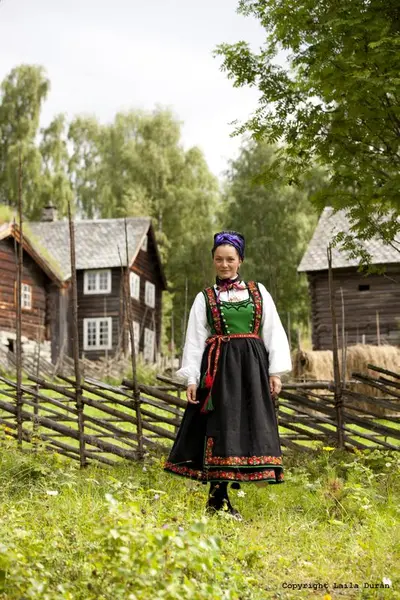The bunad has its origins in folk costumes, the locally distinctive clothing worn in Norway's pre-industrial agrarian society.
In Norway, popular interest in the wearing of folk costumes emerged in the mid 18th century, when work began on documenting the costumes in connection with surveying sources of income among the peasant class.
By the end of the 19th century, folk costumes had fallen into disuse as the industrial revolution brought the modern world closer and closer. In parallel with this, Norwegian national Romanticism emerged in the 1840s, bringing with it an appreciation of peasant culture. Folk costumes became a popular source of inspiration for artists, and people gradually adopted the wearing of these garments as an expression of national pride. In this way, folk costumes gained new relevance, albeit it with new form and content. From round the mid 19th century they became known as 'national costumes'. Garments from different parts of Norway were worn as national costumes, though the Hardanger costume proved especially popular.
Reactions to this new development came around 1900. The Norwegian nationalist movement (Norskdomsrørsla), which sought to promote Norwegian culture and which opposed the union with Sweden, wanted to revive the old peasant culture that was fast disappearing. It was more than just a Romantic infatuation; they wanted to bring an improved version of folk culture back to the rural communities.
With Hulda Garborg at the forefront, the Norwegian nationalist movement adopted the folk costumes as a key element in its struggle for a new cultural policy. Not only were old folk costumes revived, but new ones were created that featured only some elements from the old folk costumes. It was around this time that folk costumes became 'bunads'; festive and formal costumes which, to a greater or lesser extent, were a continuation of local folk costume traditions.
Up until World War I, recently discarded garments were often adopted as bunads or served as the basis on which new ones were made. This situation would soon change, however, when the concept of the bunad began being used to refer to most of what was made. It is this situation that has since become a contentious issue in the history of the bunad; that is, whether bunads should first and foremost continue folk costume traditions or whether a freely designed costume was just as good.
Today, bunads are worn as festive and formal garments by people all around Norway, and are highly valued by their owners, regardless of type and origin.
- 1/1
Women's bunad from Tinn in Telemark. Photo: Laila Durán.
